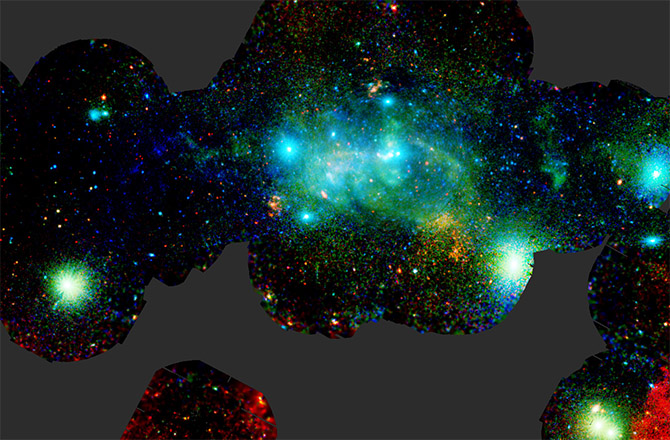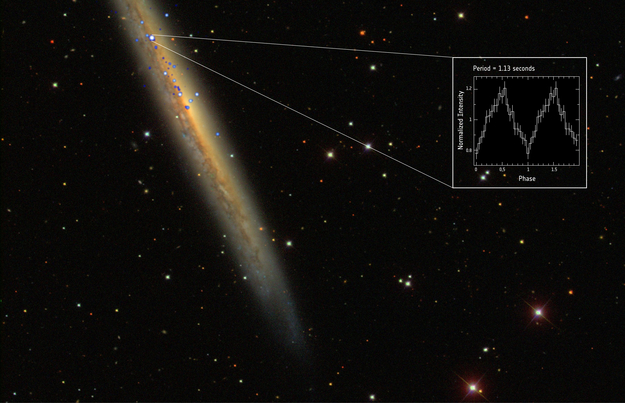XMM-Newton: Europe's Powerful X-ray Telescope

In 1999, the European Space Agency (ESA) launched what the agency calls "the most powerful X-ray telescope ever placed in orbit." For nearly two decades, the X-ray Multi-Mirror Mission (XMM) Newton telescope has probed the hot X-ray universe, hunting for missing matter, monitoring black holes and their eating habits, examining the bright centers of galaxies, and even observing planets in the solar system. Let's take a look at ESA's "flagship of European X-ray astronomy."
The mission
XMM-Newton carries three advanced X-ray telescopes. Each contains 58 high-precision nested mirrors, gives XMM a total X-ray collection area nearly the size of a tennis court, though they are each only 30 centimeters wide.
That's because each barrel-shaped telescope has 58 wafer-thin mirrors curved into cylinders and nested inside one another like Russian dolls. The mirrors sit only 25 microns apart, about a quarter the width of a human hair. Together, these mirrors will allow astronomers to make long uninterrupted observations with unprecedented accuracy.
The telescope work in conjunction with cameras, a spectrometer and an optical/ultraviolet monitor. Three European Photon Imaging Cameras (EPIC) can detect weak X-ray radiation. The Reflection Grating Spectrometer analyzes wavelengths in more detail than the EPIC.
The final instrument, the Optical/UV Monitor, which the ESA describes as "a scaled-down version of the Hubble Space Telescope," can view X-rays, and in the ultraviolet and visible wavelengths as well. The monitor's 30-centimeter viewing area has the power of a 4-meter telescope on Earth simply because it is flying above the disturbing effects of Earth's atmosphere.
Launched on December 10, 1999, from the ESA's Kourou Spaceport in French Guiana, XMM-Newton was placed in a 48-hour orbit around Earth in a highly elliptical orbit. The highly eccentric orbit keeps the instrument outside of the radiation belts surrounding Earth for 40 hours, while offering the longest possible observation periods that spend most of their time outside of Earth's shadow. The orbital period, which is exactly twice the length of Earth's rotational period, also allows the spacecraft to maintain the optimal contact with the ground stations at Kourou and Yatharaga, Australia.
In addition to its scientific acronym, the XMM-Newton telescope was named to honor one of the world's most illustrious scientists, Sir Isaac Newton. Newton's work in the field of mathematics, optics and physics laid the foundation for modern science as he had a major impact on theoretical and practical astronomy.
"We have chosen this name because Sir Isaac Newton was the man who invented spectroscopy and XMM is a spectroscopy mission" Roger Bonnet, ESA director of science, said in a statement. "The name of Newton is associated with the falling apple, which is the symbol of gravity, and with XMM I hope that we will find a large number of black hole candidates which are of course associated with the theory of gravity. There was no better choice of name than XMM-Newton for this mission."
Although the telescope is nearly two decades old, the degradation of its equipment is quite moderate, according to the ESA. The predicted instrument performance should allow research to continue for another decade. The most limiting factor is fuel. Using conservative estimates, XMM-Newton should run out of fuel around 2029, giving it a lifetime of three decades. The ESA is working on a new instrument, the Athena X-ray Observatory, with a planned launch of 2028.
The science
XMM-Newton was launched with the intent to study some of the most violent space phenomena. It was designed to investigate in detail the X-ray emission characteristics of cosmic sources such as clusters of galaxies, starburst galaxies, active galaxy nuclei, black holes, neutron stars and pulsars.
"Some astronomical sources are prominent X-ray emitters, but faint or even invisible in other parts of the electromagnetic spectrum," according to NASA. "Therefore, high-quality X-ray observations of these objects are very important and cannot be replaced by data obtained through other observing techniques."
XMM-Newton can also study supernova remnants, the hot material in between stars, and cool gas that absorbs X-rays. It can even study objects in the solar system, such as comets and the auroral activity on gas giants.

After 17 years of observation, researchers had published more than 5,000 scientific papers in refereed literature.
"XMM-Newton has established itself as one of the most prolific astronomical endeavors in ESA history," according to a statement by the ESA. "Based on data gathered through XMM-Newton observations, research studies describing discoveries in almost every field of astronomy have been produced."
While XMM-Newton has produced a wealth of outstanding research, some highlights include:
A pulsar that switches between "bright" and "quiet" modes. Simultaneous observations of the pulsar PSR B0943+10 with XMM-Newton and ground-based radio telescopes reveals that when it is bright in X-rays, it is quiet in radio waves, and vice versa.
"The behavior of this pulsar is quite startling. It's as if it has two distinct personalities," said study co-author Ben Stappers, who is with the University of Manchester's School of Physics and Astronomy.
Missing intergalactic material. While dark matter and dark energy make up about 25 and 70 percent of the universe respectively, ordinary 'baryonic' matter makes up everything else. But that last 5 percent can be a challenge to track down. By using XMM-Newton to look at aa massive galaxy with a supermassive black hole at its center, researchers were able to find signs of the diffuse, hard-to-spot gas that lies between the sun and the distant galaxy.
"The discovery of the missing baryons with XMM-Newton is the exciting first step to fully characterize the circumstances and structures in which these baryons are found," co-author Jelle Kaastra, from the Netherlands Institute for Space Research, said in a statement.
A black hole chowing down on a star for a record decade. Using XMM-Newton along with NASA's Chandra X-ray Observatory and the Neil Gehrels Swift Observatory, researchers found a star being devoured by a black hole over a decade. The extensive time frame suggests that this was either the most massive star ever to be torn apart, or the first time a smaller star was completely shredded.
"We have witnessed a star's spectacular and prolonged demise," lead author Dacheng Lin from the University of New Hampshire in Durham, New Hampshire, said in a statement. "Dozens of tidal disruption events have been detected since the 1990s, but none that remained bright for nearly as long as this one."
Jupiter's erratic auroras. Auroral displays are caused by streams of charged atomic particles colliding with the atmospheric layers of a planet, moon or star, generally filtering to their poles. On Earth, the two sets of aurorae mimic one another; when the Northern Lights brighten, the southern ones do, as well. But when researchers used XMM-Newton and Chandra to observe the high-energy X-rays produced by the auroras at Jupiter's poles, they found a different story. While the southern auroras pulsate every 11 minutes, those at the north pole flared erratically.
"This is a breakthrough finding, and it couldn't have been done without ESA's XMM-Newton," ESA project scientist for XMM-Newton Norbert Schartel said in a statement. "The space observatory was critical to this study, providing detailed data at a high spectral resolution such that the team could explore the vibrant colors of the auroras and figure out details about the particles involved: if they're moving fast, whether they're an oxygen or sulphur ion, and so on."
Additional resource
Follow Nola Taylor Redd at @NolaTRedd, Facebook or Google+. Follow us at @Spacedotcom, Facebook or Google+.
Join our Space Forums to keep talking space on the latest missions, night sky and more! And if you have a news tip, correction or comment, let us know at: community@space.com.
Get the Space.com Newsletter
Breaking space news, the latest updates on rocket launches, skywatching events and more!

Nola Taylor Tillman is a contributing writer for Space.com. She loves all things space and astronomy-related, and enjoys the opportunity to learn more. She has a Bachelor’s degree in English and Astrophysics from Agnes Scott college and served as an intern at Sky & Telescope magazine. In her free time, she homeschools her four children. Follow her on Twitter at @NolaTRedd










